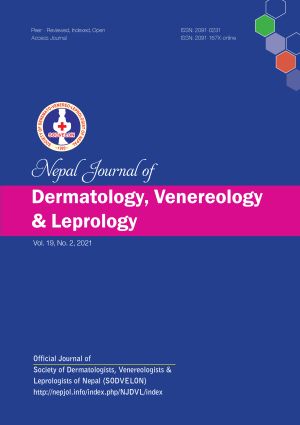Efficacy of Intense Pulse Light with Triple Combination Cream Versus Triple Combination Cream alone in the Treatment of Melasma
DOI:
https://doi.org/10.3126/njdvl.v19i2.38557Keywords:
Intense Pulse Light, Melasma, Triple Combination CreamAbstract
Introduction: Various studies explored the use of intense pulse light (IPL) therapy in treating melasma, but only a few randomized clinical trials have evaluated the combination of triple combination cream (TCC) with IPL so far.
Objective: This study compared the efficacy and safety of the combination of IPL and triple combination cream with triple combination cream alone in treating melasma.
Material and Methods: Sixty patients with melasma were enrolled in this assessor-blinded, parallel-group randomized controlled study. Thirty patients were treated with IPL (15J/cm2, two sessions at 2-week intervals) and TCC (Hydroquinone 2%, tretinoin 0.025%, fluocinolone acetonide 0.01%) at night and broad-spectrum sunscreen during day time whereas other groups received only TCC and broad-spectrum sunscreen. The median percentage reduction in melasma area and severity index (MASI) and physician’s global assessment scale was assessed at 12-week to determine the efficacy of the treatment. The incidence of adverse effects at each follow-up and relapse at 16-week were also noted during the study period as the secondary outcome measure.
Results: The median reduction in MASI achieved at 12 weeks was 48% in the IPL+TCC group and 13.1% in the TCC group from the baseline. The incidence of relapse was seen in 7.14% and 13.04% patients in the IPL+TCC group and TCC alone group respectively at 16 weeks however, this difference was not statistically significant (p<0.05).
Conclusion: Our study supports that IPL and TCC are more effective than TCC therapy alone in treating melasma.
Downloads
Downloads
Published
How to Cite
Issue
Section
License
Copyright (c) 2021 Society of Dermatologists, Venereologists and Leprologists of Nepal

This work is licensed under a Creative Commons Attribution 4.0 International License.
Copyright on any research article is transferred in full to Nepal Journal of Dermatology, Venereology & Leprology upon publication. The copyright transfer includes the right to reproduce and distribute the article in any form of reproduction (printing, electronic media or any other form).




